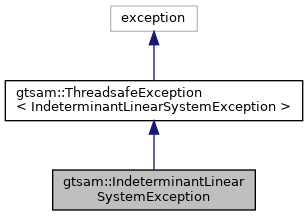#include <linearExceptions.h>
Inheritance diagram for gtsam::IndeterminantLinearSystemException:

Public Member Functions | |
| IndeterminantLinearSystemException (Key j) noexcept | |
| Key | nearbyVariable () const |
| const char * | what () const noexcept override |
| ~IndeterminantLinearSystemException () noexcept override | |
 Public Member Functions inherited from gtsam::ThreadsafeException< IndeterminantLinearSystemException > Public Member Functions inherited from gtsam::ThreadsafeException< IndeterminantLinearSystemException > | |
| const char * | what () const noexcept override |
Private Attributes | |
| Key | j_ |
Additional Inherited Members | |
 Protected Types inherited from gtsam::ThreadsafeException< IndeterminantLinearSystemException > Protected Types inherited from gtsam::ThreadsafeException< IndeterminantLinearSystemException > | |
| typedef std::allocator< char > | Allocator |
| typedef std::string | String |
 Protected Member Functions inherited from gtsam::ThreadsafeException< IndeterminantLinearSystemException > Protected Member Functions inherited from gtsam::ThreadsafeException< IndeterminantLinearSystemException > | |
| ThreadsafeException () | |
| Default constructor is protected - may only be created from derived classes. More... | |
| ThreadsafeException (const std::string &description) | |
| Construct with description string. More... | |
| ThreadsafeException (const ThreadsafeException &other) | |
| Copy constructor is protected - may only be created from derived classes. More... | |
| ~ThreadsafeException () noexcept override | |
| Default destructor doesn't have the noexcept. More... | |
 Protected Attributes inherited from gtsam::ThreadsafeException< IndeterminantLinearSystemException > Protected Attributes inherited from gtsam::ThreadsafeException< IndeterminantLinearSystemException > | |
| std::optional< String > | description_ |
| Optional description. More... | |
| bool | dynamic_ |
| Whether this object was moved. More... | |
Detailed Description
Thrown when a linear system is ill-posed. The most common cause for this error is having underconstrained variables. Mathematically, the system is either underdetermined, or its quadratic error function is concave in some directions.
Examples of situations causing this error are:
- A landmark observed by two cameras with a very small baseline will have high uncertainty in its distance from the cameras but low uncertainty in its bearing, creating a poorly-conditioned system.
- A landmark observed by only a single ProjectionFactor, RangeFactor, or BearingFactor (the landmark is not completely constrained).
- An overall scale or rigid transformation ambiguity, for example missing a prior or hard constraint on the first pose, or missing a scale constraint between the first two cameras (in structure-from-motion).
Mathematically, the following conditions cause this problem:
- Underdetermined system: This occurs when the variables are not completely constrained by factors. Even if all variables are involved in factors, the variables can still be numerically underconstrained, (for example, if a landmark is observed by only one ProjectionFactor). Mathematically in this case, the rank of the linear Jacobian or Hessian is less than the number of scalars in the system.
- Indefinite system: This condition occurs when the system Hessian is indefinite, i.e. non-positive-semidefinite. Note that this condition can also indicate an underdetermined system, but when solving with Cholesky, accumulation of numerical errors can cause the system to become indefinite (have some negative eigenvalues) even if it is in reality positive semi-definite (has some near-zero positive eigenvalues). Alternatively, if the system contains some HessianFactor's with negative eigenvalues, these can create a truly indefinite system, whose quadratic error function has negative curvature in some directions.
- Poorly-conditioned system: A system that is positive-definite (has a unique solution) but is numerically ill-conditioned can accumulate numerical errors during solving that cause the system to become indefinite later during the elimination process. Note that poorly- conditioned systems will usually have inaccurate solutions, even if they do not always trigger this error. Systems with almost- unconstrained variables or vastly different measurement uncertainties or variable units can be poorly-conditioned.
Resolving this problem:
- This exception contains the variable at which the problem was discovered (IndeterminantLinearSystemException::nearbyVariable()). Note, however, that this is not necessarily the variable where the problem originates. For example, in the case that a prior on the first camera was forgotten, it may only be another camera or landmark where the problem can be detected. Where the problem is detected depends on the graph structure and variable elimination ordering.
- MATLAB (or similar software) is a useful tool to diagnose this problem. Use GaussianFactorGraph::sparseJacobian_(), GaussianFactorGraph::sparseJacobian() GaussianFactorGraph::denseJacobian(), and GaussianFactorGraph::denseHessian() to output the linear graph in matrix format. If using the MATLAB wrapper, the returned matrices can be immediately inspected and analyzed using standard methods. If not using the MATLAB wrapper, the output of these functions may be written to text files and then loaded into MATLAB.
- When outputting linear graphs as Jacobian matrices, rows are ordered in the same order as factors in the graph, which each factor occupying the number of rows indicated by its JacobianFactor::rows() function. Each column appears in elimination ordering, as in the Ordering class. Each variable occupies the number of columns indicated by the JacobianFactor::getDim() function.
- When outputting linear graphs as Hessian matrices, rows and columns are ordered in elimination order and occupy scalars in the same way as described for Jacobian columns in the previous bullet.
Definition at line 94 of file linearExceptions.h.
Constructor & Destructor Documentation
◆ IndeterminantLinearSystemException()
|
inlinenoexcept |
Definition at line 97 of file linearExceptions.h.
◆ ~IndeterminantLinearSystemException()
|
inlineoverridenoexcept |
Definition at line 98 of file linearExceptions.h.
Member Function Documentation
◆ nearbyVariable()
|
inline |
Definition at line 99 of file linearExceptions.h.
◆ what()
|
overridenoexcept |
Definition at line 25 of file linearExceptions.cpp.
Member Data Documentation
◆ j_
|
private |
Definition at line 95 of file linearExceptions.h.
The documentation for this class was generated from the following files: